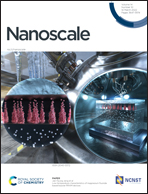Assembly mechanism of surface-functionalized nanocubes
Abstract
Faceted nanoparticles can be used as building blocks to assemble nanomaterials with exceptional optical and catalytic properties. Recent studies have shown that surface functionalization of such nanoparticles with organic molecules, polymer chains, or DNA can be used to control the separation distance and orientation of particles within their assemblies. In this study, we computationally investigate the mechanism of assembly of nanocubes grafted with short-chain molecules. Our approach involves computing the interaction free energy landscape of a pair of such nanocubes via Monte Carlo simulations and using the Dijkstra algorithm to determine the minimum free energy pathway connecting key states in the landscape. We find that the assembly pathway of nanocubes is very rugged involving multiple energy barriers and metastable states. Analysis of nanocube configurations along the pathway reveals that the assembly mechanism is dominated by sliding motion of nanocubes relative to each other punctuated by their local dissociation at grafting points involving lineal separation and rolling motions. The height of energy barriers between metastable states depends on factors such as the interaction strength and surface roughness of the nanocubes and the steric repulsion from the grafts. These results imply that the observed assembly configuration of nanocubes depends not only on their globally stable minimum free energy state but also on the assembly pathway leading to this state. The free energy landscapes and assembly pathways presented in this study along with the proposed guidelines for engineering such pathways should be useful to researchers aiming to achieve uniform nanostructures from self-assembly of faceted nanoparticles.



 Please wait while we load your content...
Please wait while we load your content...